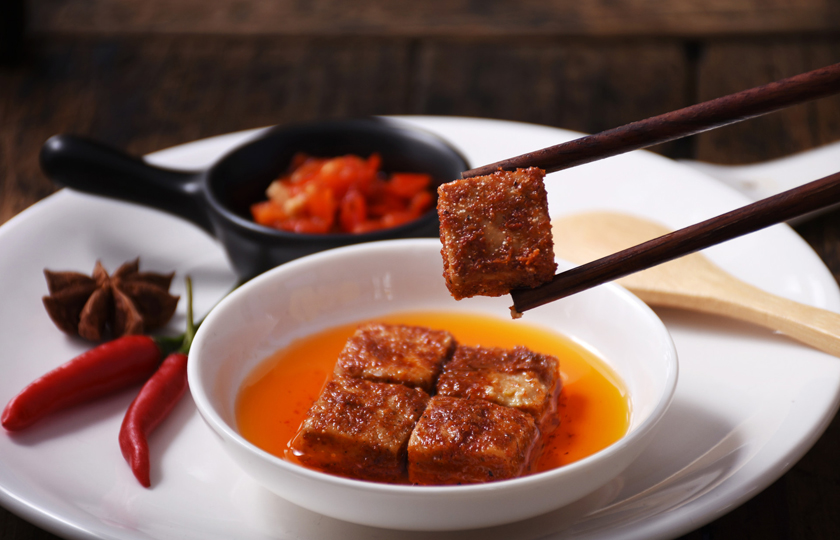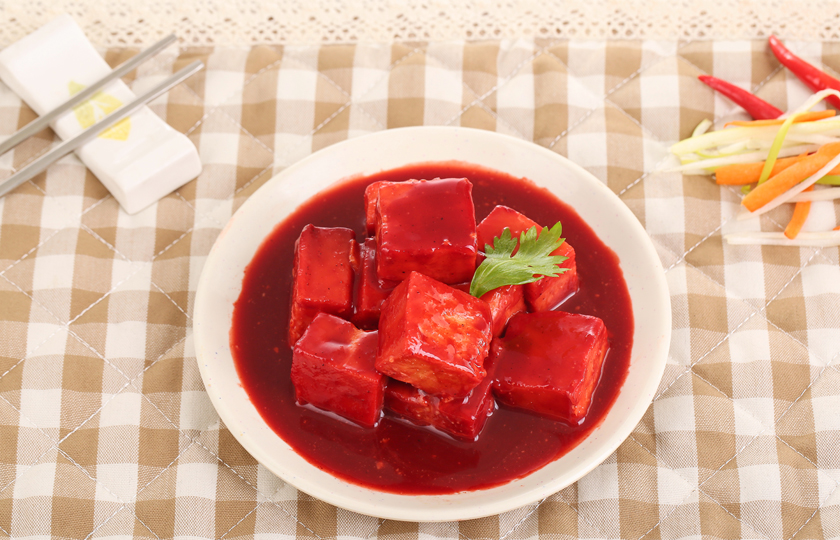Explore the differences between fermented tofu and regular tofu

Regular tofu and fermented tofu look similar, but they are very different. Regular tofu has a fresh flavor, a pure taste, a smooth texture, and a wide range of uses. However, fermented tofu is carefully processed, has a rich flavor, and a unique texture. These differences are not only reflected in flavor and texture, but also in culinary uses. Now, let's see how the two types of tofu differ.
Different production methods
Tofu: It is made by soaking soybeans, grinding, boiling, brine (using coagulants such as plaster of Paris, brine, or gluconolactone, etc.) and pressing.
Fermented tofu: The production process is relatively complicated. It is made on the basis of regular tofu through a specific fermentation process. During the production process, a layer of mold hyphae will grow on the surface of the tofu block (these fungi do not produce toxins, let alone cause disease), and then salt, wine, spices and other seasonings will be added. After pickling, filling, and late fermentation, fermented tofu with a unique flavor is finally formed.
Different taste
Regular tofu: The texture is relatively firm, the taste is tender and delicate, the taste is light, and it has the natural aroma of soybeans.
Fermented tofu: The taste is relatively denser, the texture is softer, and it melts in the mouth. And because it has been fermented and pickled, it has a rich and mellow taste. There are many flavors such as salty and fat. Different types of fermented tofu, such as spicy fermented tofu, also have the stimulating taste of chili.

Different nutritional ingredients
Ordinary tofu: Ordinary tofu is an important source of high-quality plant protein, and it also contains a certain amount of nutrients such as fat, carbohydrates, vitamins and minerals. It has a high protein content and is easy to digest and absorb.
Fermented tofu: During the fermentation process of fermented tofu, due to the action of microorganisms, the protein is broken down into amino acids, which increases the digestion and absorption rate of protein. At the same time, fermentation also increases the content of vitamins, especially B vitamins. However, since more salt is added to fermented tofu during the pickling process, its salt content is high and it is not suitable for excessive consumption.
Different ways of eating
Ordinary tofu can be eaten in a variety of ways. It can be cooked into various dishes, such as mapo tofu, tofu soup, etc., or it can be eaten directly, such as cold tofu.
Fermented tofu is usually used as a seasoning or side dish. It can be eaten with staple foods such as rice and steamed buns, or it can be used to add flavor to cooking dishes. In addition, fermented tofu can be eaten directly as a side dish or hot pot dipping sauce.
Why do people eat fermented tofu?
From the perspective of dietary tradition, fermented tofu has a long history of production and consumption in Asian countries such as China. It is one of the local traditional delicacies and has a profound cultural heritage. People may like to eat fermented tofu because of their love and inheritance of traditional culture. Fermented tofu is also easy to store and carry, making it convenient for people to eat at any time. Moreover, after fermentation, fermented tofu will produce a unique aroma, with strong bean and fat aroma, delicate and soft taste, which can stimulate appetite. In cooking, it is a good seasoning. It can be used in meat cooking to remove fishy smell and enhance fragrance, and can also be used for pickling and making dipping sauces.

What is a substitute for fermented tofu?
Doubanjiang
Doubanjiang has a strong bean and salty flavor, and can play a similar seasoning role in cooking as fermented tofu. For example, when cooking or stewing, using Doubanjiang instead of fermented tofu can add a mellow flavor to the dishes. For example, when making braised fish, adding bean paste will give the fish a strong aroma and a bright red color.
Sweet noodle sauce
The taste of sweet noodle sauce is sweet and salty, and the texture is delicate. If it is used for dipping, such as dipping steamed buns or vegetables, sweet noodle sauce can be used as a substitute for fermented bean curd. Sweet noodle sauce can also play a role in cooking some meat dishes, such as Beijing sauce shredded pork, which is wrapped with sweet noodle sauce and has a strong taste.
Shrimp paste
Shrimp paste has a unique seafood flavor and is salty and fresh. For those who like the taste of seafood, shrimp paste can be used instead of fermented bean curd when cooking seafood or vegetable dishes. For example, adding shrimp paste when stir-frying water spinach will give the water spinach a strong seafood flavor, which is unique.
Shacha sauce
Shacha sauce is a mixed sauce with a variety of flavors such as sweet, spicy, fresh, and fragrant. When making hot pot dipping sauce or mixed noodles, shacha sauce can replace fermented bean curd. It can add rich flavor layers to food. For example, in shacha noodles in southern Fujian, shacha sauce is the key seasoning.
Is fermented tofu the same as stinky tofu?
Of course they are different.
Stinky tofu is a classic snack in Changsha, while fermented tofu is mainly used as a seasoning or side dish.
Although they are both fermented from tofu, there are many differences.
First, they use different types of microorganisms. Stinky tofu is mainly fermented with Bacillus circulans, while fermented tofu is generally fermented with molds (such as Mucor).
Because of the difference in fermentation microorganisms, the two are very different in flavor and smell. Stinky tofu has a distinct odor, while fermented tofu has a rich and salty unique taste.
In addition, the two are also different in appearance color. The common color of stinky tofu is mainly black, while fermented tofu is mostly red and yellow.























